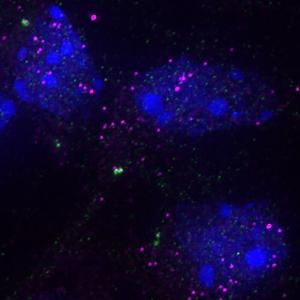Cell Biology: Diversity of centrosomes
17 Jun 2022
Scientists from LMU and Helmholtz Munich have gained new insights into the human centrosome, whose malfunction is linked to many neurodevelopmental disorders.
17 Jun 2022
Scientists from LMU and Helmholtz Munich have gained new insights into the human centrosome, whose malfunction is linked to many neurodevelopmental disorders.

Image of specific RNAs (magenta) at the centrosome (green) in mouse cortex cells. The cell nucleus is labeled in blue. | © © Helmholtz Zentrum München / Giulia Antognolli
The centrosome is the organelle responsible for the organization of the cytoskeleton during cell division, an essential function in organisms from yeast to humans. Until now, scientists assumed that the centrosome was very similar in all cells due to its general tasks. A team led by Magdalena Götz, Head of LMU Department of Physiological Genomics, Director of the Institute for Stem Cell Research (ISF) at Helmholtz Munich and member of the Cluster of Excellence SyNergy, now evaluated this notion in neurons and their developmental precursors, so-called neuronal stem cells. “There is so much we don't yet know about these cells, including how the centrosomes of neurons compare to those of neural stem cells and other cell types,” Götz says. Their subsequent discoveries now fundamentally challenge the assumption that all centrosomes are created equal.
In close collaboration with the Helmholtz Munich Proteomic Core Facility led by Stefanie Hauck, the researchers found that the composition of proteins in centrosomes differs profoundly depending on the cell type. “We were surprised not only by the unexpected high degree of heterogeneity of the centrosomes, but also by the discovery of many unexpected proteins associated with them – for example, RNA-binding proteins and even proteins responsible for splicing (the processing of RNA), which normally takes place in the nucleus,” Götz explains.
The scientists discovered that a specific protein (the ubiquitously expressed splicing protein PRPF6) is enriched at the centrosome in neural stem cells, but not in neurons. A mutation of the protein found in patients with brain malformation periventricular heterotopia also leads to a similar phenotype in animal models. Magdalena Götz concludes, “This means that the location of a protein is crucial for a disease. With our centrosome analysis, we now have an important resource to test further associations with neuronal diseases. In particular, our research can explain for the first time why a protein that is present in all cells, after mutation, causes a phenotype only in the brain, but not in other organs. This will allow further insights into disease mechanisms – and thus get one step closer to their treatment.”
O’Neill, Uzbas, Antognolli, Merino et al.: Spatial centrosome proteome of human neural cells uncovers disease-relevant heterogeneity. Science 2022.